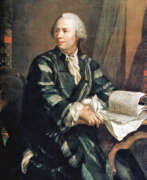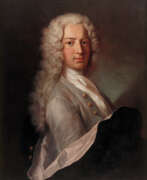Mathematicians 18th century


Jakob Bernoulli was a Swiss mathematician. One of the founders of probability theory and mathematical analysis. Johann Bernoulli's older brother. Proved a special case of the law of large numbers - Bernoulli's theorem. Professor of Mathematics at the University of Basel (since 1687). Foreign member of the Paris Academy of Sciences (1699) and the Berlin Academy of Sciences (1702).
Jacob Bernoulli contributed greatly to the development of analytical geometry and the birth of the calculus of variations. Bernoulli's lemniscate is named after him. He also investigated the cycloid, the chain line, and especially the logarithmic spiral. The last of these curves Jacob willed to be drawn on his grave; through ignorance, Archimedes' spiral was depicted there.
Jacob Bernoulli is credited with significant achievements in series theory, differential calculus, probability theory, and number theory, where the "Bernoulli numbers" are named after him.


Bernard Bolzano, full name Bernard Placidus Johann Nepomuk Bolzano, was an Italian-born Czech scientist, mathematician, logician, philosopher and theologian.
Bolzano graduated from the University of Prague and was immediately appointed professor of philosophy and religion at the university. Within a few years, however, Bolzano had already shown himself to be a free thinker with his teachings on the social costs of militarism and the needlessness of war. He called for a complete reform of the educational, social, and economic systems that would direct the nation's interests toward peace rather than armed conflict between states. In 1819, Bolzano was expelled from the university for his beliefs and thereafter turned his full attention to works on social, religious, philosophical, and mathematical issues.
Bolzano held advanced views on logic, mathematical quantities, limits, and continuity. He is the author of the first rigorous theory of real numbers and one of the founders of set theory. In his studies of the physical aspects of force, space, and time, he proposed theories opposed to those advanced by the German philosopher Immanuel Kant. His contributions to logic, in particular, established his reputation as the greatest logician of his time. Much of his work remained unpublished during his lifetime and was not widely disseminated until the late nineteenth and early twentieth centuries, when a number of his conclusions were reached independently.
Bolzano was multi-talented in various fields of science to which he made significant contributions. His published works include The Binomial Theorem (1816), A Purely Analytic Proof (1817), The Functional Model and the Scientific Model (1834), An Attempt at a New Statement of Logic (1837), and The Paradoxes of Infinity (1851).
Among other things, Bolzano was also a great philanthropist. Together with his friends and students, he supported the activities of almshouses, homes for the blind, loan banks for the working class, libraries, and elementary schools in rural areas.


Joachim Bouvet was a French Jesuit monk and missionary who worked in China.
Joachim Bouvet was one of six Jesuit mathematicians chosen by Louis XIV to travel to China as his envoys and work as missionaries and scholars. In 1687 in Beijing, Bouvet began this work, especially in mathematics and astronomy, and in 1697 the Chinese emperor Kangxi (1654-1722) sent him as ambassador to the French king. Kangxi expressed his wish that Bouvet should bring more missionary scientists with him. Thus, in addition to his scholarly work, Bouvet was also an accomplished diplomat and served as a liaison between the Chinese Emperor Kangxi and King Louis XIV of France.
Bouvet brought to France a manuscript describing Kangxi's life with an eye for diplomatic subtleties, as well as a collection of drawings depicting graceful Chinese figures in traditional and ceremonial dress. The first French edition of The Historical Portrait of the Emperor of China was published in Paris in 1697, and was subsequently translated and published in other languages. And Bouvet returned to China in 1699 with ten new missionaries and a collection of King Louis XIV's engravings for Emperor Kangxi. He remained in China for the rest of his life.


Leonhard Euler was the greatest mathematician of the 18th century and history in general.
Euler brilliantly graduated from the University of Basel and entered the St. Petersburg Academy of Sciences, then began to work at the Berlin Academy, and later to lead it. In 1766, the scientist received an invitation from the Russian Empress Catherine II and again came to St. Petersburg to continue his scientific work.
Here he published about 470 works in a wide variety of fields. One of them is a large-scale work "Mechanics" - an in-depth study of this science, including celestial mechanics. Euler by that time was practically blind, but continued to be actively engaged in science, in the records he was helped by his son Johann Albrecht and stenographers. Leonhard Euler made many fundamental discoveries that brought great benefit to mankind.
His massive contribution to the development of mathematics, mechanics, physics and astronomy cannot be overestimated, and his knowledge in the most diverse branches of science is admirable. During his lifetime, he published more than 850 works that contain in-depth studies of botany, chemistry, medicine, ancient languages, and music. Euler held membership in many academies of science around the world.


Joseph Fourier, full name Jean-Baptiste Joseph Fourier, was a French mathematician and physicist and historical Egyptologist.
Fourier famously accompanied Napoleon Bonaparte on his Egyptian expedition in 1798 as a scientific advisor and was appointed secretary of the Institute of Egypt. During the occupation of Egypt, Fourier worked in the French administration, supervised archaeological excavations, and worked to shape the educational system.
But the main thing in Fourier's life was science. Back in France, he studied the mathematical theory of heat conduction, established the partial differential equation governing heat diffusion, and solved it using an infinite series of trigonometric functions. Fourier showed that heat diffusion obeyed simple observable physical constants that could be expressed mathematically. His work The Analytic Theory of Heat (1822) had a great influence on the development of physics and pure mathematics.
Joseph Fourier was a member of the Paris Academy of Sciences, the French Academy, a foreign honorary member of the St. Petersburg Academy of Sciences, and a member of the Royal Society of London.


Gottfried Wilhelm Leibniz was a German philosopher and a prominent polymath in many fields of science.
Leibniz was a universal genius; he showed his talents in logic, mathematics, mechanics, physics, law, history, diplomacy, and linguistics, and in each of the disciplines he has serious scientific achievements. As a philosopher, he was a leading exponent of 17th-century rationalism and idealism.
Leibniz was a tireless worker and the greatest scholar of his time. In the fate of Leibniz, among other things, there is one interesting page: in 1697, he accidentally met the Russian Tsar Peter I during his trip to Europe. Their further meetings led to the realization of several grandiose projects in Russia, one of which was the establishment of the Academy of Sciences in St. Petersburg.
Gottfried Wilhelm Leibniz was also the founder and first president of the Berlin Academy of Sciences and a member of the Royal Society of London.


Isaac Newton was an English mathematician, physicist, astronomer, alchemist, theologian, and author (described in his time as a "natural philosopher"), widely recognised as one of the greatest mathematicians and physicists and among the most influential scientists of all time. He was a key figure in the philosophical revolution known as the Enlightenment. His book Philosophiæ Naturalis Principia Mathematica (Mathematical Principles of Natural Philosophy), first published in 1687, established classical mechanics. Newton also made seminal contributions to optics, and shares credit with German mathematician Gottfried Wilhelm Leibniz for developing infinitesimal calculus.
In the Principia, Newton formulated the laws of motion and universal gravitation that formed the dominant scientific viewpoint until it was superseded by the theory of relativity. Newton used his mathematical description of gravity to derive Kepler's laws of planetary motion, account for tides, the trajectories of comets, the precession of the equinoxes and other phenomena, eradicating doubt about the Solar System's heliocentricity. He demonstrated that the motion of objects on Earth and celestial bodies could be accounted for by the same principles. Newton's inference that the Earth is an oblate spheroid was later confirmed by the geodetic measurements of Maupertuis, La Condamine, and others, convincing most European scientists of the superiority of Newtonian mechanics over earlier systems.


Giovanni Vincenzo Petrini was an Italian priest and theologian, philosopher, mathematician, and expert in mineralogy.
Along with Scipio Breislacus, Petrini was one of the founders of Italian volcanology. He taught philosophy and mathematics, theology, but specialized in mineralogy and created the Mineralogical Cabinet in Nazareth. This museum was famous in Europe and was visited, among others, by Emperor Joseph II, who gave him rare specimens from the lands of the Empire and especially from Hungary.
Giovanni Petrini was the author of the catalog Gabinetto mineralogico del Collegio Nazareno ("The Mineralogical Cabinet of the Nazarene Collegium, described by external features and distributed by component parts" (Rome, 1791-1792). The specimens in it are classified according to a standard structure: salts, earths, bitumens, combustibles, and metals. There is also a section on gemstones.


Giuseppe Piazzi was an Italian astronomer, mathematician and priest.
Around 1764 Piazzi became a Theatine priest, in 1779 he was appointed professor of theology in Rome, and in 1780 - professor of higher mathematics at the Academy of Palermo. Later, with the assistance of the Viceroy of Sicily, he founded an observatory in Palermo. There he compiled his great catalog of the positions of 7,646 stars and showed that most stars move relative to the Sun. There, on January 1, 1801, Piazzi also discovered the asteroid Ceres.
Giuseppe Piazzi's merits were appreciated: he was a member of the Royal Society of London, a foreign honorary member of the St. Petersburg Academy of Sciences and a foreign member of the Paris Academy of Sciences. A crater on the Moon is named in his honor.


Franz Xaver Freiherr (from 1801) von Zach, Baron (Hungarian: Zách János Ferenc) was an Austro-German astronomer, surveyor, mathematician, science historian and officer of Hungarian origin. He rendered outstanding services in the exploration of the solar system and the organization of international astronomy, after whom a lunar crater (Zach) and an asteroid ((999) Zachia) were named, among others. He was also the founder of the first scientific journals and organised the first astronomical congress in 1798.


Johann Zahn (German: Johann or Johannes Zahn) was a German scientist and philosopher, optician and astronomer, mathematician and inventor.
Zahn studied mathematics and physics at the University of Würzburg, was professor of mathematics at the University of Würzburg, and served as a canon of the Order of Regular Canon Premonstratensians. His other activities were optics as well as astronomical observations.
In 1686 Johann Zahn invented and designed a portable camera obscura with fixed lenses and an adjustable mirror, which is the prototype of the camera. In his treatise on optics, Oculus Artificialis Teledioptricus (1702), Zahn gives a complete picture of the state of optical science of his time. He begins with basic information about the eye and then moves on to optical instruments. The book is aimed at eighteenth-century microscope and telescope enthusiasts and includes all the necessary details of construction, from lens grinding to drawings.





























